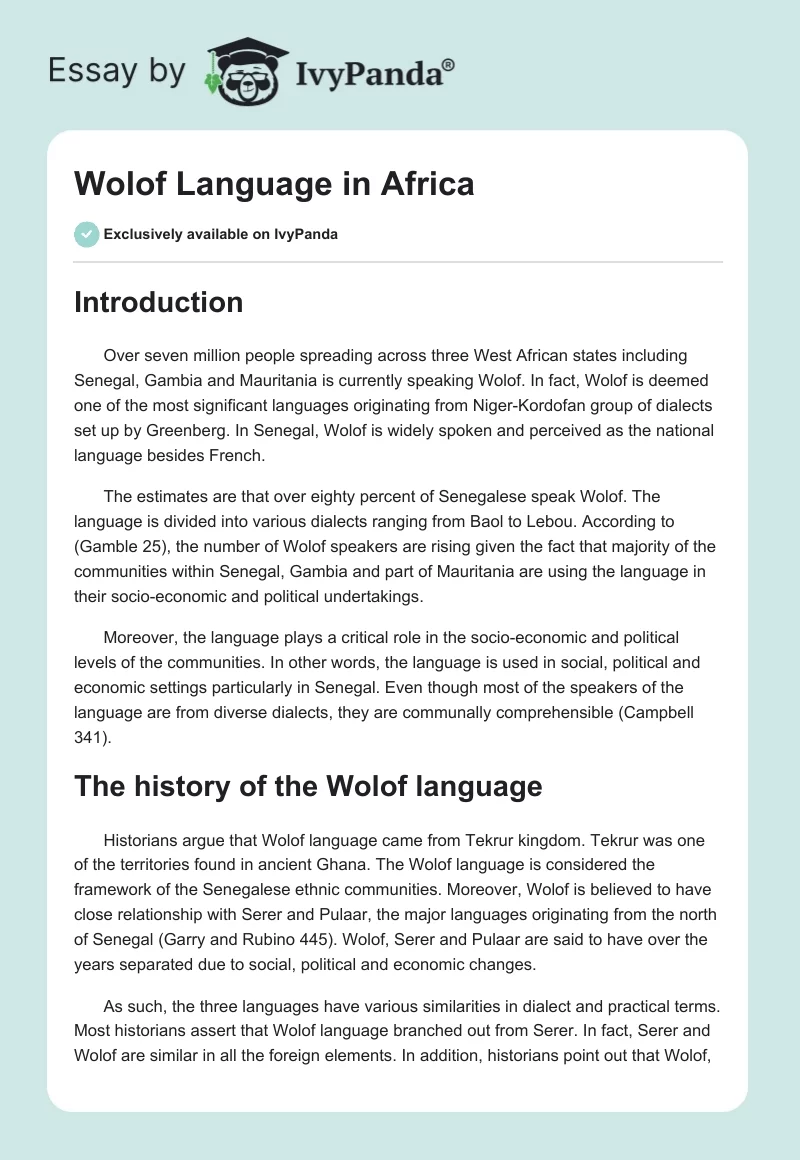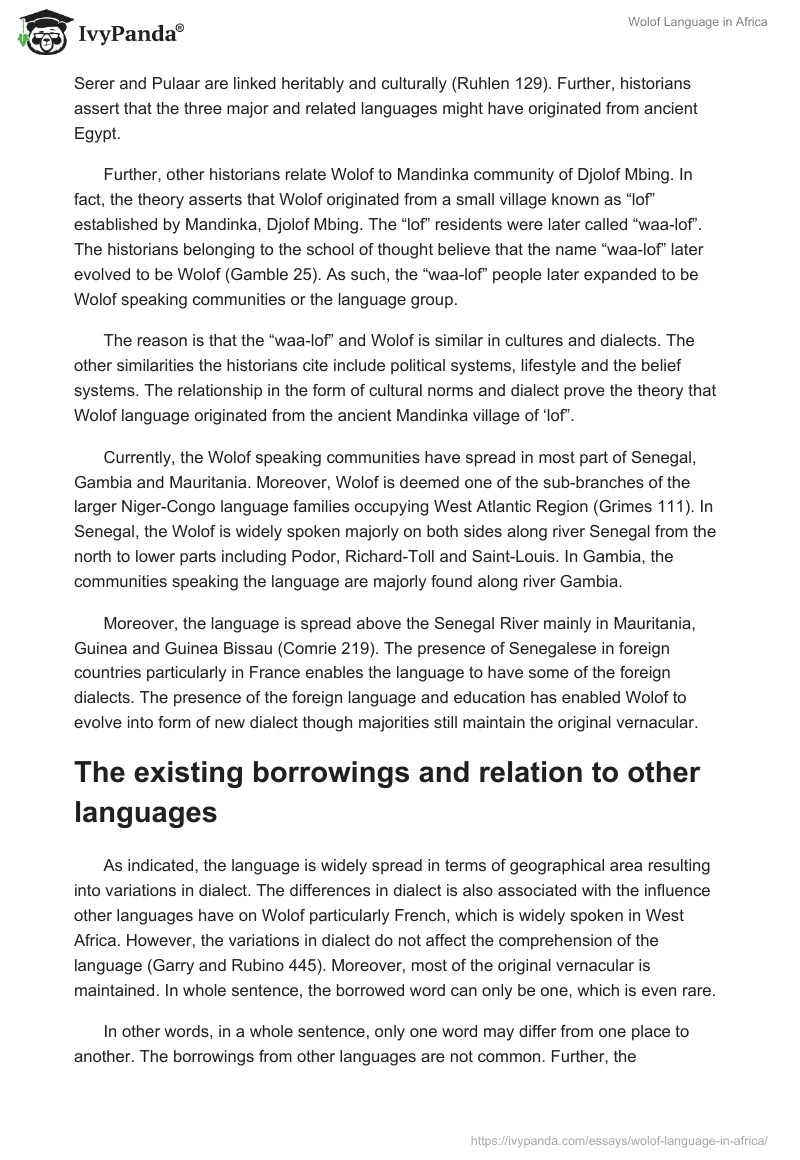Introduction
Over seven million people spreading across three West African states including Senegal, Gambia and Mauritania is currently speaking Wolof. In fact, Wolof is deemed one of the most significant languages originating from Niger-Kordofan group of dialects set up by Greenberg. In Senegal, Wolof is widely spoken and perceived as the national language besides French.
The estimates are that over eighty percent of Senegalese speak Wolof. The language is divided into various dialects ranging from Baol to Lebou. According to (Gamble 25), the number of Wolof speakers are rising given the fact that majority of the communities within Senegal, Gambia and part of Mauritania are using the language in their socio-economic and political undertakings.
Moreover, the language plays a critical role in the socio-economic and political levels of the communities. In other words, the language is used in social, political and economic settings particularly in Senegal. Even though most of the speakers of the language are from diverse dialects, they are communally comprehensible (Campbell 341).
The history of the Wolof language
Historians argue that Wolof language came from Tekrur kingdom. Tekrur was one of the territories found in ancient Ghana. The Wolof language is considered the framework of the Senegalese ethnic communities. Moreover, Wolof is believed to have close relationship with Serer and Pulaar, the major languages originating from the north of Senegal (Garry and Rubino 445). Wolof, Serer and Pulaar are said to have over the years separated due to social, political and economic changes.
As such, the three languages have various similarities in dialect and practical terms. Most historians assert that Wolof language branched out from Serer. In fact, Serer and Wolof are similar in all the foreign elements. In addition, historians point out that Wolof, Serer and Pulaar are linked heritably and culturally (Ruhlen 129). Further, historians assert that the three major and related languages might have originated from ancient Egypt.
Further, other historians relate Wolof to Mandinka community of Djolof Mbing. In fact, the theory asserts that Wolof originated from a small village known as “lof” established by Mandinka, Djolof Mbing. The “lof” residents were later called “waa-lof”. The historians belonging to the school of thought believe that the name “waa-lof” later evolved to be Wolof (Gamble 25). As such, the “waa-lof” people later expanded to be Wolof speaking communities or the language group.
The reason is that the “waa-lof” and Wolof is similar in cultures and dialects. The other similarities the historians cite include political systems, lifestyle and the belief systems. The relationship in the form of cultural norms and dialect prove the theory that Wolof language originated from the ancient Mandinka village of ‘lof”.
Currently, the Wolof speaking communities have spread in most part of Senegal, Gambia and Mauritania. Moreover, Wolof is deemed one of the sub-branches of the larger Niger-Congo language families occupying West Atlantic Region (Grimes 111). In Senegal, the Wolof is widely spoken majorly on both sides along river Senegal from the north to lower parts including Podor, Richard-Toll and Saint-Louis. In Gambia, the communities speaking the language are majorly found along river Gambia.
Moreover, the language is spread above the Senegal River mainly in Mauritania, Guinea and Guinea Bissau (Comrie 219). The presence of Senegalese in foreign countries particularly in France enables the language to have some of the foreign dialects. The presence of the foreign language and education has enabled Wolof to evolve into form of new dialect though majorities still maintain the original vernacular.
The existing borrowings and relation to other languages
As indicated, the language is widely spread in terms of geographical area resulting into variations in dialect. The differences in dialect is also associated with the influence other languages have on Wolof particularly French, which is widely spoken in West Africa. However, the variations in dialect do not affect the comprehension of the language (Garry and Rubino 445). Moreover, most of the original vernacular is maintained. In whole sentence, the borrowed word can only be one, which is even rare.
In other words, in a whole sentence, only one word may differ from one place to another. The borrowings from other languages are not common. Further, the distinctions in dialects are insignificant since such dialectical variation cannot prevent other people from understanding the verbal communication. Essentially, the mutual intelligibility is highly maintained among the Wolof speaking communities (Grimes 111).
However, wide variation is observed in Wolof language spoken in urban and rural areas. The variations originate from the pressure of modernization in urban centers where majority interact with various languages and the maintenance of the original vernacular in the rural areas. Some of the terms are frequently used in the rural areas as opposed to urban centers where foreign borrowed dialects are common (Ruhlen 134).
In other words, some terms are specific to the rural dialect. People living in the downtown cannot understand such terms. Similarly, some dialects are specific to urban areas and are commonly borrowed from foreign languages particularly French. For instance, words such as “Jatan” and “Naaf” are common in rural areas while words including “Garaas” and “oto” commonly used in urban areas are borrowed from French words “Garage” and “Automobile”.
Further, the increased rate of modernity and influence in education exert more pressure on urban dwellers. As a result, the urban dwellers constantly create new words and use many French borrowings, which are directly related to political, economic and social transformations existing in urban centers. On the contrary, the rural dwellers are quite conservative and use dialects that are ignored or disregarded in modern cities (Gamble 25).
The interactions with the French language has also led to differences in some terms such as toilet which is referred to “douche” in town while in rural areas, the original term “wanag” is used. The contacts Wolof has with other languages also have influence in some areas such as in Saint Louis. The city of Saint Louis, being near Mauritania, has borrowed the term “Kaudir” meaning pan, which the rest of Senegalese Wolof communities term “Cin”.
The regional diversity also contributes to the Wolof dialectical differences. The reason explains the differences observed in Senegalese Wolof dialects from the Gambian Wolof languages. The changes in the Gambian Wolof dialects are influenced by English language given the fact that Gambia is a former British colony.
The influence of English is not obvious in Senegalese Wolof dialects as opposed to French (Grimes 113). The English borrowings are only common with hip-hop singers in Senegal. In Gambia, English language greatly influenced the Wolof dialects where coined English are replacing some terms.
The recent changes in Wolof language related to technological innovations
Even though technological advancement has little influence on the changes taking place within the Wolof language, few transformations have taken place particularly in terms and pronunciations. Advanced technology has also facilitated the borrowing of some terms. Terms that did not originally exist in Wolof dialect are now incorporated.
In other words, technology has led to the creation of new terms (Gamble 25). The new terms have enriched the Wolof vocabulary particularly in urban centers. However, the advancement in technology has facilitated the rate of influence foreign languages have on Wolof dialects.
Moreover, technological advancements result in differences of some terms used in particular urban areas as opposed to rural areas. For instance, in Dakar, where majority are educated and apply modern technological gadgets, common terms are being replaced with the French or English terminologies of the gadgets. From time to time, new words are being inserted in place of original terms in Wolof or words considered old-fashioned in urban areas (Campbell 341).
For instance, the term “muus” originating from the mouse of a computer is constantly replacing the Wolof term “wundu” which is still being used in most areas. Even though there are changes resulting from technological advancements particularly in some terms, large transformations have not occurred.
Wolof language and its chances for a change
Wolof language has specific characteristics that differentiate it from other languages. Moreover, Wolof language has specific attributes that differentiate it from other national languages spoken in Senegal and Gambia where Wolof speaking communities are widely spread. One of the attributes is the role the language plays in society since it is the only vehicular language (Garry and Rubino 456). In other words, unlike other vernacular national languages, communities and not the whole population speak Wolof.
In addition, everybody in social and political setting including the media uses Wolof. Further, the language is largely used within the economic domains particularly in commercial and urban centers (Gamble 25). Almost all commercial transactions in Senegal and Gambia are conducted in Wolof. The application of the language in social, political and economic settings increases the need to know and comprehend Wolof detriment to other languages.
One of the major characteristics of the Wolof language is persistence during the colonial era. The language did not change despite wide spread of the use of French and English (Comrie 224). In other words, Wolof language was not greatly influenced by the foreign colonial languages. The attribute distinguishes the language from other African languages that were victims of colonial influence.
Despite widespread use of French language in West Africa and its influence on other African languages, Wolof dialects remained though with little borrowings. The characteristic contributes to little chances in the transformation of the language. Even though the chances of the language changing exist, it will take time before significant transformations are observed (Garry and Rubino 456).
However, modes at which the language has borrowed words from other languages have increased in the recent past. In other words, the rate of transformation is likely to increase due to pressure from modernization and education (Comrie 231). Moreover, modern technological advancements are also likely to increase the rate of transformation. Generally, modernity will be the major cause of transformation of the language.
Conclusion
Wolof is widely spoken across three West African states including Senegal, Gambia and Mauritania. The language plays a critical role in the socio-economic and political levels of the communities.
Even though most of the speakers of the language are from diverse dialects, they are communally comprehensible. Despite widespread use of French language in West Africa and its influence on other African languages, Wolof dialects remained though with little borrowings. The characteristic contributes to little chances in the transformation of the language.
Works Cited
Campbell, George. Compendium of the World’s Languages. London, Routledge, 2000. Print.
Comrie, Benard. The World’s Major Languages. New York, Oxford University Press, 2007. Print.
Gamble, David. Elementary Gambian Wolof Grammar. Brisbane, CA, Summer Institute of Linguistics, 2001. Print.
Garry, Jane and Carl Rubino. Facts about the World’s Languages: An Encyclopedia of the World’s Major Languages, Past and Present. New York, The H. W. Wilson Company, 2001. Print.
Grimes, Barbara. Ethnologue, Languages of the World. Dallas, TX, Summer Institute of Linguistics, 2009. Print.
Ruhlen, Merritt. A Guide to the World’s Languages. London, Edward Arnold, 2007. Print.


